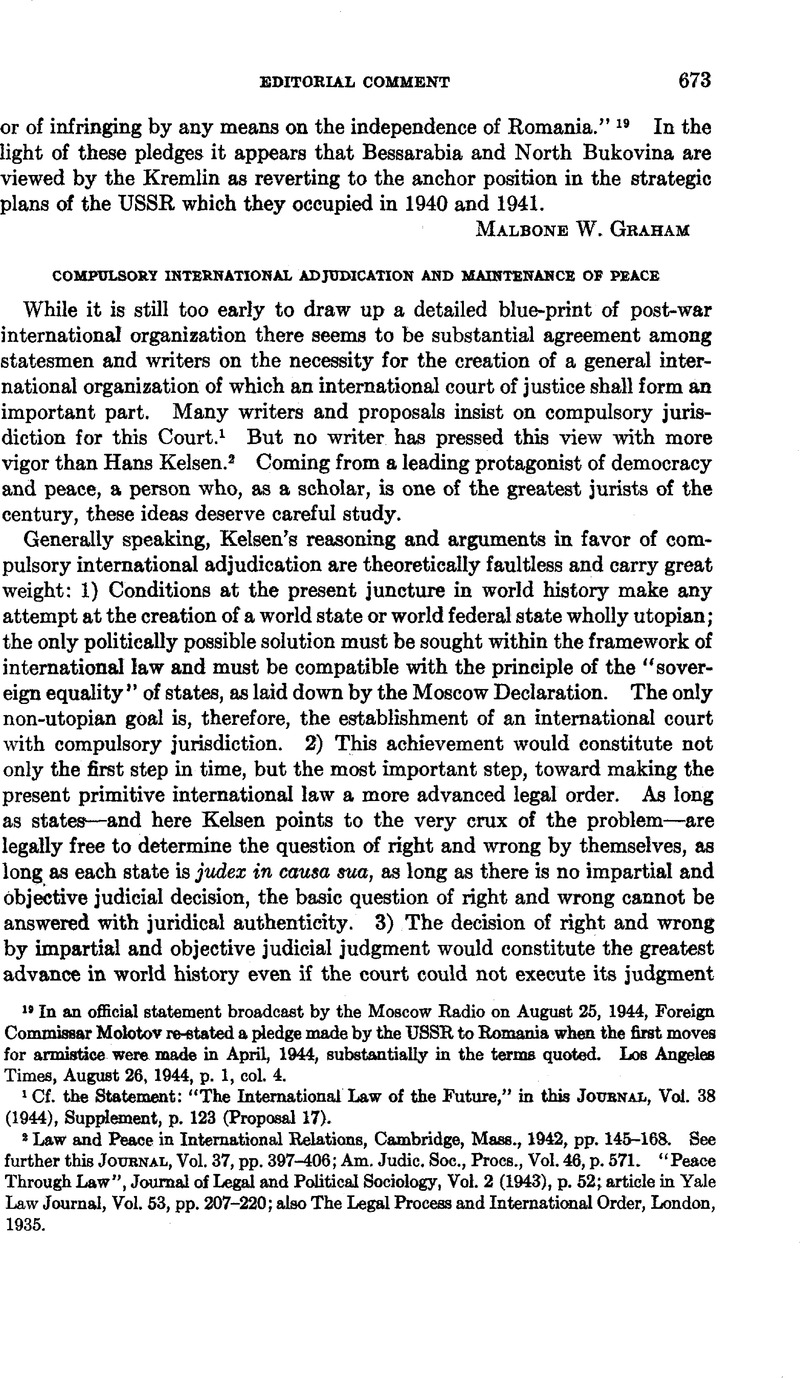Article contents
Compulsory International Adjudication and Maintenance of Peace
Published online by Cambridge University Press: 25 April 2017
Abstract

- Type
- Editorial Comment
- Information
- Copyright
- Copyright © by the American Society of International Law 1944
References
1 Cf. the Statement: “The International Law of the Future,” in this Journal, Vol. 38 (1944), Supplement, p. 123 (Proposal 17).
2 Law and Peace in International Relations, Cambridge, Mass., 1942, pp. 145–168. See further this Journal, Vol. 37, pp. 397–406; Am. Judic. Soc., Procs., Vol. 46, p. 571. “Peace Through Law”, Journal of Legal and Political Sociology, Vol. 2 (1943), p. 52; article in Yale Law Journal, Vol. 53, pp. 207–220; also The Legal Process and International Order, London, 1935.
3 Cf. the President’s Statement: “We are not thinking of a super-state with its own police force and other paraphernalia of coercive power” (New York Times, June 16, 1944, p. 12).
4 The Legal Process, etc., p. 23.
5 Kelsen’s historical argument was made use of by Uruguay at the Lima Conference in its proposal for international adjudication (“ inspirdndose en aquel concepto bdsico que enunciaba Kelsen”; Oclava Conferencia International Americana, Lima, 19S8. Didrio de Sesiones, Lima, 1939, p. 141).
6 Lauterpacht, H.: The Function of Law in the International Community, Oxford, 1933 Google Scholar, in general. Also Schindler, D. in Hague Academy of International Law, Recueil des Cours, Vol. 25, pp. 235–364 Google Scholar.
7 Lauterpacht’s: “De maximis non curat praetor.”
8 Cf. Prime Minister Churchill’s speech in the House of Commons of May 24, 1944, in which he strongly underlined his reliance on superior power and on a “world-controlling Council, comprising the greatest states which emerge victorious from this war, to prevent wars and enforce peace.” (New York Times, May 25,1944, pp. 12,13.) Cf. also the statement by the President of the United States (same, June 16, 1944, p. 12).
9 Cf. the proposals by Uruguay and Mexico at the Lima Conference' (Didrio de Sesiones, Lima, 1939, pp. 114–140, 140–142).
10 The formula of the Taft-Knox Treaties of 1911, characterizing such conflicts as “justiciable” in their nature “by reason of being susceptible of decision by the application of the principles of law and equity,” is certainly theoretically untenable. Little can also be said in favor of the enumeration method. The distinction between “legal” and “political” conflicts with regard to the importance of the matter in controversy is equally untenable.
11 Cf. Huber, M. in Annuaire de I’Institut de Droit International, Vol. XXXIII, p. 262 Google Scholar.
12 M. Habicht, The Power of the International Judge to give a decision ex aequo et bono, London, 1935, p. 80.
13 Justice O. W. Holmes in Southern Pacific Co. v. Jensen, 1917, 244 U. S. 205, 221.
- 1
- Cited by




